Making Tumbled Glass With a Rock Tumbler
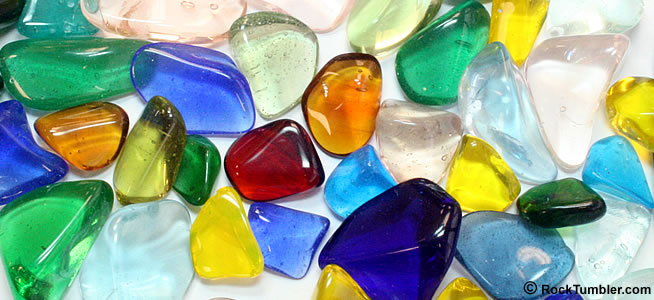
We start with landscape glass that can be purchased at many home improvement and garden supply stores. After five days of tumbling in medium grit, it was converted into some nice nuggets of "frosted glass." If you want brightly polished glass, you can tumble the glass in two more steps: 1) in fine grit, then in 2) TXP polish. This can make some really gemmy pieces of polished glass.
Lots of people use tumbled glass for ground cover in potted plants, making jewelry, and an enormous variety of craft and home decor projects.
Lots of people use tumbled glass for ground cover in potted plants, making jewelry, and an enormous variety of craft and home decor projects.
In this video we demonstrate how to make tumbled glass using a rotary rock tumbler. Our product will be very similar to the "beach glass" or "sea glass" that can be found along coastlines.
Can I Make Tumbled Glass in My Rock Tumbler?
Lots of people have asked... "Can I make polished glass in my rock tumbler"?
The answer to that question is: Maybe. It depends upon the speed of your tumbler.
If you have a rotary rock tumbler with a barrel that turns slowly (under about 50 to 60 barrel revolutions per minute) then you will likely be able to make nice tumbled glass that is polished to a bright luster. The Thumler's Tumblers that we sell all turn at speeds of about 50 barrel revolutions per minute or less. We have used them to make lots of tumbled glass.
Their barrel speeds are: MP-1 (50 brpm), A-R1 (40 brpm), A-R2 (35 brpm), A-R12 (22 brpm), and Model B (20 brpm). Lortone tumblers also turn at speeds low enough to make nice tumbled glass.
However, if your tumbler turns at a speed of about 90 barrel revolutions per minute or higher, then your polished glass will likely be bruised or fractured. Many of the toy tumblers and beginners tumblers sold today have barrels that turn so rapidly that polished glass is badly damaged - even if the tumbler has a speed control and you operate it at the slowest speed!
Tumbling Glass - Some Basics
If you have experience at tumbling rocks, there are a few things that you should know before tumbling glass.
First: Glass is softer than most rocks
Glass is much softer than agate, jasper, and most other rocks that are typically processed in a rock tumbler. Glass has a hardness of between four and six on the Mohs Hardness Scale while agates and jaspers have a hardness of about seven.
Glass is softer than agate. It will take less time to tumble. We usually skip the coarse grit step.
Second: Glass is not as tough as most rocks
The second thing that you need to know is that glass is not as "tough" as jasper or agate. (Toughness is the resistance of a material to chipping and breaking.) So, when you tumble glass, it is very important to have the proper amount of material in the barrel. If there is not enough material in the barrel, the glass will be tossed violently around in the barrel, and your pieces of glass will be chipped or broken. (Watch our video to see what happens when a tumbler barrel is not filled properly.)
In addition to filling the barrel properly, it is important to have a range of particle sizes in the barrel. If your load consists mainly of large pieces of glass (greater than 1 inch in diameter), adding some small ceramic pellets to the load will fill the spaces between the glass particles, cushion the glass-to-glass impacts, and increase the amount of grinding that occurs.
We add three or four heaping tablespoons of ceramic pellets per pound of glass - or enough to fill most of the spaces between the pieces of glass. We use these pellets for both rotary tumblers and vibratory tumblers.
If you don't have enough glass to fill the tumbler to the proper level, large ceramic pellets are a convenient way to bring the barrel up to the proper 2/3 full level.
Third: Bottle glass performs poorly
Lots of people think that broken bottle glass will be great for tumbling. Many have already collected a lot of bottle glass and are excited about using it.
They are almost always disappointed because many bottles have very thin walls. Those pieces of thin, curved glass produce very fragile and very dangerous pieces of polished glass.
The nicest pieces of polished glass are produced when you start with chunky pieces. We never tumble glass unless we have pieces that measure at least 1/2 inch across their MINIMUM dimension, and we avoid glass in curved pieces.
Fourth: Large pieces of glass cause damage
Small rock tumblers work best for pieces of glass that are between 1/2" and 1 1/2" inch in size (that size is measured across the MAXIMUM dimension of the piece). The larger the pieces of glass in your tumbler, the more likely they will be bruised or fractured.
Large pieces of glass hit one another with a lot more energy than small pieces of glass. The ultimate destruction occurs when large pieces of glass are placed in one of the super-fast tumblers described in the first section of this article.
Maybe you recognize this equation: E = M x C2... where E = energy, M = mass, and C = velocity.
The energy of impact is proportional to the mass of the impactors times their relative velocity squared. That means large pieces of glass in a fast tumbler are going to break one another.
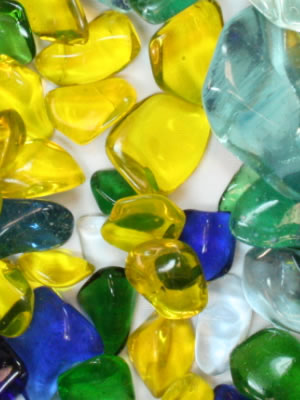
Tumble-polished glass. We started with landscape glass and followed the instructions used to tumble rocks.
The Challenge of Polishing Glass
Glass is one of the more challenging materials to tumble. Its lack of toughness is the problem. If you want to get good results, you must fill the tumbler barrel to the proper level and have plenty of small-size glass to fill the empty spaces between bigger pieces. If you don't have small pieces of glass, you can use ceramic pellets.
Just giving you another warning before you start your tumbler - we don't want you to open it to find that every piece of glass is chipped or bruised.
Frosted Glass? or Polished Glass?
Some people who tumble glass want pieces with a "frosted" surface - similar to the sea glass that they find at a beach. Others want a highly "polished" transparent glass with a gemmy appearance. The difference between these two is in the amount of processing done in the rock tumbler.
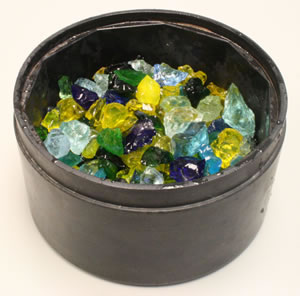
Rough pieces of landscape glass ready for tumbling! We are going to add some small ceramic pellets to fill the spaces between the pieces of glass and bring the barrel up to 2/3 full. Watch the video near the top of this page for more details.
"Landscape glass" is used as a ground cover in shrubbery and gardens. It is sold at some gardening supply and home improvement stores.
"Landscape glass" is used as a ground cover in shrubbery and gardens. It is sold at some gardening supply and home improvement stores.
Instructions for Frosted Glass
(Pieces Between 1/2" and 1 1/2")
If you want frosted glass, simply run the glass through Step 2 of our rock tumbling instructions (skip Step 1). However, instead of running the glass for seven days, stop the tumbler and check the glass after just four or five days. If the glass is not rounded to your satisfaction, clean the lid of the barrel and the rim where it seals, then close the barrel and run for a few more days.
If the pieces of glass are rounded to your satisfaction, clean it up, dry it and examine the luster. If you like the frosted finish, then you can stop tumbling and enjoy your glass. If you want a higher luster on the pieces of glass, then after you are finished with Step 2, follow Step 3 of our rock tumbling instructions for two or three days. Be sure to make the tumbler barrel between 1/2 and 2/3 full. If your glass has lost a lot of volume, you can add enough ceramic pellets to bring the barrel up to the proper level. (When adding ceramic pellets at this step, be sure that they have been previously used. Brand-new pellets often have sharp edges that can scratch your glass.)
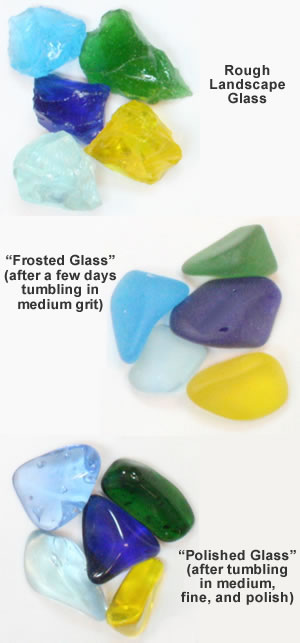
These photos summarize our landscape glass tumbling project. At the top is the landscape glass straight from the garden supply store. The center photo shows the "frosted glass nuggets" that we had after just five days of tumbling in medium grit. The bottom photo shows the gemmy pieces of tumbled glass that we had after the four-step tumbling process.
Instructions for Polished Glass
(Pieces Between 1/2" and 1 1/2")
If you want a brightly polished luster, then move on to Step 3 of our rock tumbling instructions. We run Step 3 for about three days. Then we do Step 4, the polishing step, for four to seven days. For polish we use TXP aluminum oxide. It has worked great on all of the glasses that we have tumbled. We have also used cerium oxide with nice results, but it is a very expensive polish.
Thirty minutes of burnishing usually improves the luster of tumbled glass. So, after the polishing step we tumble about thirty minutes in water containing about one level tablespoon of shavings from a bar of Ivory soap per pound of glass.
Should I Use Sand Instead of Grit?
Some people use beach sand instead of silicon carbide grit when they tumble glass. They believe that this more closely mimics the actions of waves and currents at the beach for shaping their glass. If you want frosted glass, you can get great results using sand; however, it will require more days of tumbling to produce nicely rounded glass pieces. This is because most beach sand is mainly composed of quartz, which has a hardness of 7, while silicon carbide grit has a hardness of 9. That means silicon carbide grit will wear the glass down much faster.
Some Rocks Are Natural Glass
In fact, many people who tumble rocks might have tumbled a natural glass without realizing it. Apache Tears and obsidian are volcanic rocks and natural volcanic glasses. Man-made glass can be tumbled using the same techniques used for polishing these natural glasses.
What Type of Glass to Tumble?
Recycling facilities sometimes sell "cullet" (the industry term for crushed glass). Some facilities sell it in mixed or separated colors. Be sure that you will get nice chunky pieces at least 1/4" thick.
Glass manufacturing companies and glass repair shops can be sources of broken glass for tumbling. Stained glass shops can also be a place to obtain small pieces of colored glass that are left over from their work or too small to use in a project. These can be great for tumbling. Call these businesses in your town and ask - they might enjoy an opportunity to recycle their glass.
Some garden supply stores sell landscaping glass in a variety of colors. This is often a by-product of the glass recycling industry. It can be successfully tumbled if the chunks of glass are not heavily fractured. Watch our video at the top of this page - we show you how we tumbled a batch of landscape glass.
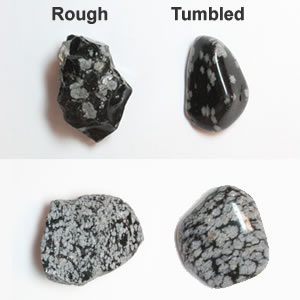
These are pieces of snowflake obsidian, a volcanic rock that is a natural glass. Rough pieces are on the left and tumble-polished pieces are on the right.
Be Careful!
Whatever source you use to obtain your glass, be careful!
- Glass is sharp and will cut you
- Wear gloves and protective clothing
- Wear goggles or safety glasses
- Wear a dust mask - glass dust is deadly
- Instead of breaking glass yourself, we recommend purchasing landscape glass or cullet
Glass Can Make Gas :o
Some types of glass will produce a gas while running in a tumbler. Because of this we always advise people to wear safety glasses when opening tumbler barrels to protect your eyes from possible splash or spatter of tumbling grit or rock mud. If your rubber barrel is bulging, open it carefully to allow the gas to escape.
In cases of extreme gas build-up, it can pop the lid off of a rotary rock tumbler barrel. That will spill the contents of the barrel all over your tumbler and the floor. It is not a fun mess to clean up.
To avoid problems you should check your tumbler barrel a couple times a day. If gas is building up in the barrel, it will cause the bottom of a rubber tumbler barrel to bulge. If you are familiar with the barrel, you can press on the bottom to see if it is soft or hard from a gas build-up.
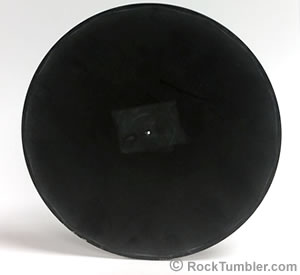
Shown here is a Thumler's 2-pound and 3-pound barrel lid with a small hole in the center. Cover the hole with tape during tumbling and use the hole to relieve any pressure that builds up.
The problem with the lid popping off of a Lot-o-Tumbler is that the small amount of moisture in the barrel will evaporate, and your glass will become welded together in the dry rock mud. The solution is simple! Poke a tiny hole in the red cap to allow the gas pressure to seep out.
We drilled a tiny hole in the lid of our small Thumler's rotary tumbler barrel and covered it with tape. To release gas in the barrel, we simply peel back the tape, clean the lid and then apply a new piece of tape. See accompanying photo.
For more information about gas in a rock tumbler barrel, see our article titled: "Gas In the Rock Tumbler Barrel?"
Have Fun!
We really enjoy tumbling glass because it produces gemmy, transparent tumbled stones in vibrant colors. They look great in a necklace, and make brilliant vase fillers or attractive ground cover for potted plants. You will find lots of great uses for your frosted or polished glass.
Happy Tumbling!
RockTumbler.com Authors
 |
Hobart M. King has decades of rock tumbling experience and writes most of the articles on RockTumbler.com. He has a PhD in geology and is a GIA graduate gemologist. He also writes the articles about rocks, minerals and gems on Geology.com. |

